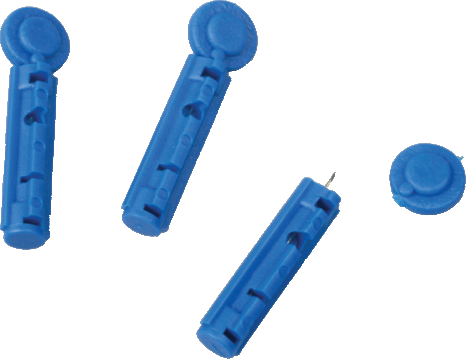
Ref. No.: NME000202
Blood lancets are small, sharp needles that are used to collect a sample of blood from the patient's fingertip. They are typically made of plastic or metal and have a pointed tip and a knob or handle that is used to twist the lancet into the skin. The needle pierces the skin to release a droplet of blood so the doctor can test it.
Plastic Blood Lancet, Twist Top, Light Blue Color. Item. No.: NME000202
If you are a diabetic, you know that finger pricks are a part of your daily life. While they may seem like a pain, they are actually crucial to maintaining your health. That's because finger pricks allow you to test your blood sugar levels and make sure that they stay within a healthy range. But how do you actually get the blood out of your finger? That's where blood lancets come in. A blood lancet is a small, sharp device that is used to make a quick, shallow cut in the skin. This allows you to collect a small drop of blood, which you can then use for testing purposes. There are many different types of blood lancets available on the market, so it's important to choose one that is right for you. Some factors to consider include the size of the lancet, the depth of the puncture, and the material it is made from. You will also want to consider how easy the lancet is to use and dispose of. Blood lancets are an essential tool for diabetics, so be sure to choose one that meets your needs.
There are two main types of blood lancets: finger sticks and arm sticks. Finger sticks are the most common type of blood lancet. They are small, easy to use, and cause minimal pain. Arm sticks are larger and require more skill to use. They are used when a larger volume of blood is needed, such as for a blood test. Finger sticks are less painful than arm sticks because the needle is smaller and doesn't go as deep into the skin. Arm sticks are more likely to cause bruising because the needle is larger and goes deeper into the skin.
There are two types of lancets: safety lancets and conventional lancets. Safety lancets are designed to protect the user from accidental needle sticks. They typically have a retractable needle that is exposed only when the device is activated. Conventional lancets do not have a safety mechanism and can be reused.
To keep your blood lancet in working order, it is important to regularly clean and disinfect the device. You should also replace the lancet blade after each use. To clean your lancet, first remove the disposable lancet from the device. Next, wipe down the exterior of the lancet with a damp cloth. Be sure to avoid getting any water inside the lancet. Once you have wiped down the exterior, reattach the disposable lancet and dispose of it in a sharps container. To disinfect your lancet, simply soak it in rubbing alcohol for at least 30 seconds. You can then dry it off with a clean cloth or allow it to air dry. It is important to replace the lancet blade after each use. To do this, first remove the old blade by gently pulling on it. Next, insert the new blade into the slot at the top of the lancet until you hear it click into place.